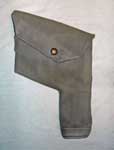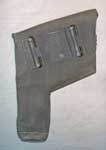Web Equipment for Officers (R.A.F.)
Equipment Carriers
The R.A.F. W.E.O. was not simply the Army pattern made in blue-grey, as it was only intended as a means of carrying side-arms, not as a full field equipment. It therefore incorporated features unique to this one pattern, which had not been seen before and which were never used again. There was never a blue-grey Rucksack, although curious provision was made for a Sword frog, despite there being no evidence that the R.A.F. ever introduced a web Frog. In the R.F.C. - an Army corps - there appears to have been a reluctance to conduct air-to-air combat with swords. In consequence, for the R.A.F., the sword was very much a ceremonial item! Aside from officers in the Levies, who used a Sam Browne Belt, the attractive eagle pommel R.A.F. sword was only ever worn on slings, carried on a decorative waist belt. All components were in “fine-weave” webbing.
 This was not listed, being an existing item, but was specified in the text of A.M.W.O. 475 / 1927. The short, wide form of I.P. bottle, in enamelled form, had been introduced in the 19th C, but the Dress Regulations for Officers, 1900 introduced a new aluminium pattern, covered in drab cloth. The bottle was of kidney-shaped cross section, with a cork stopper chained to the neck of the bottle. At some point, the drab cloth was changed to blue-grey serge. Although not the manufacturer, Mills undertook to supply the bottle at 8/-, which was almost treble the price of an enamelled Mark VI bottle, priced by the Army at 3/1d in their 1924 Priced Vocabulary. Nothing but the best, for the Boys In Blue. From the John Bodsworth Collection, photograph © John Bodsworth 2010.
This was not listed, being an existing item, but was specified in the text of A.M.W.O. 475 / 1927. The short, wide form of I.P. bottle, in enamelled form, had been introduced in the 19th C, but the Dress Regulations for Officers, 1900 introduced a new aluminium pattern, covered in drab cloth. The bottle was of kidney-shaped cross section, with a cork stopper chained to the neck of the bottle. At some point, the drab cloth was changed to blue-grey serge. Although not the manufacturer, Mills undertook to supply the bottle at 8/-, which was almost treble the price of an enamelled Mark VI bottle, priced by the Army at 3/1d in their 1924 Priced Vocabulary. Nothing but the best, for the Boys In Blue. From the John Bodsworth Collection, photograph © John Bodsworth 2010.
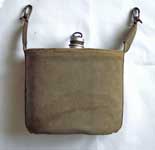
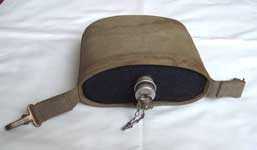
 Introduced by A.M.W.O. 475 / 1927, it was a “bucket type” Carrier, specifically intended for the “…standard Indian pattern water-bottle…”. These were the short, wide aluminium design, made regulation in the Army’s 1900 Dress Regulations and which were covered in khaki cloth. The sleeved form of the Carrier meant the khaki cloth was hidden and saved an expense in re-covering, for any ex-Army officers who had transferred to the R.A.F.. The abbreviated design of Braces meant there were no Brace ends for the attachment of Haversack, or Water-bottle. The Carrier therefore had snap-hooks, but of “levered” form, quite unlike any noted for the Army’s W.E.O. From the John Bodsworth Collection, photographs © John Bodsworth 2010.
Introduced by A.M.W.O. 475 / 1927, it was a “bucket type” Carrier, specifically intended for the “…standard Indian pattern water-bottle…”. These were the short, wide aluminium design, made regulation in the Army’s 1900 Dress Regulations and which were covered in khaki cloth. The sleeved form of the Carrier meant the khaki cloth was hidden and saved an expense in re-covering, for any ex-Army officers who had transferred to the R.A.F.. The abbreviated design of Braces meant there were no Brace ends for the attachment of Haversack, or Water-bottle. The Carrier therefore had snap-hooks, but of “levered” form, quite unlike any noted for the Army’s W.E.O. From the John Bodsworth Collection, photographs © John Bodsworth 2010.
This was a shorter Holster, more “square” in appearance, as the press fastener halves were differently aligned. The flap was more at right angles to the barrel section, the Colt Auto having a shorter overall length from muzzle to butt heel. As with the revolver Holster, the wooden muzzle plug gave way to a webbing cap.
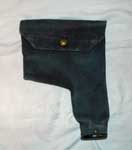
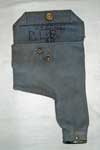
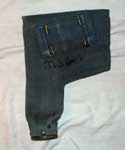 ThisHolster demonstrates the form of the early type with the "cotton reel" wooden plug at the base. This particular Holster is Air Ministry marked and is therefore properly Patt. '25 W.E., but it is identical to the W.E.O. Holster in every way except markings. It is maker marked M.E. Co. and dated 1928.
ThisHolster demonstrates the form of the early type with the "cotton reel" wooden plug at the base. This particular Holster is Air Ministry marked and is therefore properly Patt. '25 W.E., but it is identical to the W.E.O. Holster in every way except markings. It is maker marked M.E. Co. and dated 1928.

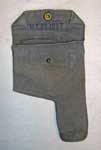
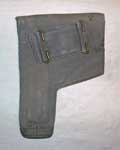 This W.E.O. R.A.F. Holster is an example of the later type automatic pistol Holster. In the photo at centre, note the location of the crown fastener on the flap. This example is maker marked M.E. Co. and dated 1937. Both Holsters are from the Karkee Web Collection.
This W.E.O. R.A.F. Holster is an example of the later type automatic pistol Holster. In the photo at centre, note the location of the crown fastener on the flap. This example is maker marked M.E. Co. and dated 1937. Both Holsters are from the Karkee Web Collection.
The .455-in. Webley Mark VI revolver had two barrel lengths, 4 and 6-inches, so officers had to specify which Holster was required. In form, these were identical to Patt., ’19 W.E. Holsters, integrally woven and with the muzzle ends closed off by a wooden “cotton reel” nailed into the open end. On the rear face, a pair of 2.25-inch “C” hooks were held in position by a thin web patch. There was no third, transverse “C” clip, as with Patt. ’37 W.E. Holsters. The two halves of the press fastener were positioned to angle the closure flap, which was necessary for the angled butt of the .455-in. Webley Mark VI. From 1934/5, the wooden plug was changed to a webbing cap, stiffened with fibreboard. The Holster was to be worn on the left side of the Belt and there was no sleeve for a cleaning rod. What? Officers clean their own pistol? There were batmen for that!


 The 1st type Holster for the Pistol, Webley, with 6-inch barrel is shown left. This example is for a revolver with a 6-inch barrel, but M.E. Co. would make these Holsters to order for any length barrel, as specified by the buyer. This example is maker marked M.E. Co. and dated 1930, and is from the Rog Dennis Collection. Photographs © Rog Dennis 2010. KW does not have photos of this type Holster made for a pistol with a 4-inch barrel. However, in everything except colour, this type is identical to the first type Case, pistol, for W.E. Pattern 1919. And by the way, that inked-over marking is the result of a boy's "restoration". He'd found it on a rubbish tip!
The 1st type Holster for the Pistol, Webley, with 6-inch barrel is shown left. This example is for a revolver with a 6-inch barrel, but M.E. Co. would make these Holsters to order for any length barrel, as specified by the buyer. This example is maker marked M.E. Co. and dated 1930, and is from the Rog Dennis Collection. Photographs © Rog Dennis 2010. KW does not have photos of this type Holster made for a pistol with a 4-inch barrel. However, in everything except colour, this type is identical to the first type Case, pistol, for W.E. Pattern 1919. And by the way, that inked-over marking is the result of a boy's "restoration". He'd found it on a rubbish tip!


 The 2nd type Holster for the Pistol, Webley, with 6-inch barrel eliminated the wooden cotton reel and was all web, as mentioned it above. This example is not maker marked or dated, but it is British manufactured. We can tell this because there is an old-style U.S. import mark of "ENGLAND" on the bottom of the muzzle cap. From the Terry Hawker Collection. Photographs © Terry Hawker and Cathy Davis, 2013.
The 2nd type Holster for the Pistol, Webley, with 6-inch barrel eliminated the wooden cotton reel and was all web, as mentioned it above. This example is not maker marked or dated, but it is British manufactured. We can tell this because there is an old-style U.S. import mark of "ENGLAND" on the bottom of the muzzle cap. From the Terry Hawker Collection. Photographs © Terry Hawker and Cathy Davis, 2013.
Shown left is another example of the 2nd type W.E.O. R.A.F. revolver Holster. This Holster is smaller than the example shown above, and was made for the Pistol, revolver, No. 2, Mk. I, which came into service with the R.A.F. in 1938. In the photo at centre, note the location of the crown fastener on the flap. This example is maker marked M.E. Co. and dated 1939, and is from the Karkee Web Collection.

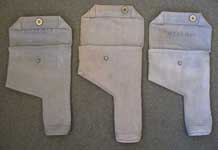 Examples of three 2nd issue R.A.F. W.E.O. Holsters. Left to right, these were made for the .Pistol, Colt, automatic, .455", the .455-inch Pistol, Webley, with 6-inch barrel, and the .38-inch Pistol, revolver, No. 2, Mk. I.
Examples of three 2nd issue R.A.F. W.E.O. Holsters. Left to right, these were made for the .Pistol, Colt, automatic, .455", the .455-inch Pistol, Webley, with 6-inch barrel, and the .38-inch Pistol, revolver, No. 2, Mk. I.
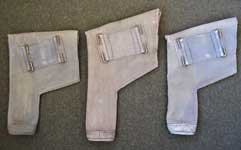
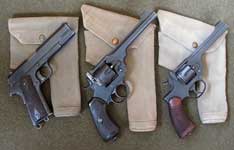 Additional photos of the same three Holsters, this time with their respective pistols shown as well. From the Terry Hawker and Karkee Web Collections. Photographs © Terry Hawker and Cathy Davis, 2013.
Additional photos of the same three Holsters, this time with their respective pistols shown as well. From the Terry Hawker and Karkee Web Collections. Photographs © Terry Hawker and Cathy Davis, 2013.
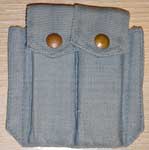
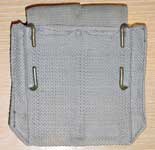 Inherited from its Royal Flying Corps forebears, the R.A.F. had a regulation automatic pistol, the Colt .455-in., using the same semi-rimmed round as the Webley Automatic, which had also featured as an R.F.C. pistol. A.M.W.O. 284 / 1926 was set out for “…Pouch, ammunition. Specially shaped to carry revolver ammunition or two automatic pistol magazines…” The wording was poorly chosen, implying a dual-purpose pouch, when in fact there were two quite different pouches. That for the Colt derived direct from the U.S. M-1912 Carrier, but had its two long pockets closed by separate flaps. The body of the Carrier was integrally woven, double-size and then folded, with brass “C” hooks of 2.25-inch accommodation sandwiched between the resulting layers, the hook ends protruding through the weave of the material. The example shown here is unmarked and undated. It could have been intended for either for W.E.O. or Pattern 1925, since both used Carriers that were identical except for markings. From the Rog Dennis Collection, photographs © Rog Dennis 2009.
Inherited from its Royal Flying Corps forebears, the R.A.F. had a regulation automatic pistol, the Colt .455-in., using the same semi-rimmed round as the Webley Automatic, which had also featured as an R.F.C. pistol. A.M.W.O. 284 / 1926 was set out for “…Pouch, ammunition. Specially shaped to carry revolver ammunition or two automatic pistol magazines…” The wording was poorly chosen, implying a dual-purpose pouch, when in fact there were two quite different pouches. That for the Colt derived direct from the U.S. M-1912 Carrier, but had its two long pockets closed by separate flaps. The body of the Carrier was integrally woven, double-size and then folded, with brass “C” hooks of 2.25-inch accommodation sandwiched between the resulting layers, the hook ends protruding through the weave of the material. The example shown here is unmarked and undated. It could have been intended for either for W.E.O. or Pattern 1925, since both used Carriers that were identical except for markings. From the Rog Dennis Collection, photographs © Rog Dennis 2009.
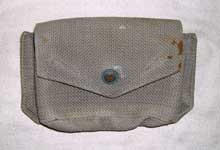

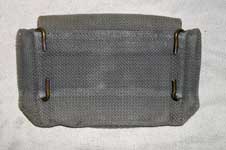 This was for revolver ammunition and took the form of the Patt. ’19 W.E. design. The belt hooks were sandwiched between the folded, two layers of webbing, the prongs protruding directly through the weave of the material. In 1932, A.M.O. A.44 authorised a change, to be incorporated into existing Pouches by modification, with new production being of the revised form. A guard strip, 1-inch wide, in thin webbing, was to be stitched to the forward edge and sides of the pouch. This was to obviate the loss of loose rounds, when the flap was open. The example shown here is maker marked M.E. Co. and date 1939. From the Karkee Web Collection.
This was for revolver ammunition and took the form of the Patt. ’19 W.E. design. The belt hooks were sandwiched between the folded, two layers of webbing, the prongs protruding directly through the weave of the material. In 1932, A.M.O. A.44 authorised a change, to be incorporated into existing Pouches by modification, with new production being of the revised form. A guard strip, 1-inch wide, in thin webbing, was to be stitched to the forward edge and sides of the pouch. This was to obviate the loss of loose rounds, when the flap was open. The example shown here is maker marked M.E. Co. and date 1939. From the Karkee Web Collection.
NOTE ON .455-in. AMMUNITION
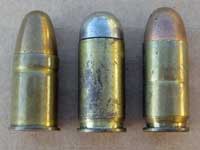
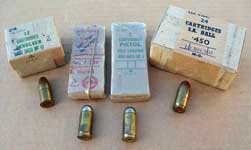 Despite a requirement to use pistols taking issue ammunition, any officer purchasing a .455-in. Colt M1911 had already made a decision to use a round that was less widely available within the Army, so would probably be responsible for his own ammunition supply. The .455 Webley revolver round (far left) was rimmed, whereas the .455 auto round (centre left) was semi-rimmed. At near left is a .45 ACP (Automatic Colt Pistol) round which was a rimless cartridge. Between 1912 and July 1915, 4,200 Colts were imported into the U.K. and were calibre .45 ACP. From 1915 to 1919, 13,300 .455 Colt Autos were imported, of which 600 were for commercial sale and 2,200 for the War Office, the balance going to the R.F.C.. The semi-rimmed round was used by the Royal Navy, who had adopted the Webley Automatic pistol as a limited standard. One hundred Webley Autos were also issued to the Royal Horse Artillery and Royal Flying Corps. The latter Corps had also received 10,200 Colt .455-in. Automatic, starting around 1917, which used the same Webley Auto round. Having effectively ignored the requirement to use the more common revolver round, there was no reason why his choice of pistol might be other than a Colt, in calibres other than .455-in. too. Cartridges from the Terry Hawker Collection. Photograph © Terry Hawker, 2010.
Despite a requirement to use pistols taking issue ammunition, any officer purchasing a .455-in. Colt M1911 had already made a decision to use a round that was less widely available within the Army, so would probably be responsible for his own ammunition supply. The .455 Webley revolver round (far left) was rimmed, whereas the .455 auto round (centre left) was semi-rimmed. At near left is a .45 ACP (Automatic Colt Pistol) round which was a rimless cartridge. Between 1912 and July 1915, 4,200 Colts were imported into the U.K. and were calibre .45 ACP. From 1915 to 1919, 13,300 .455 Colt Autos were imported, of which 600 were for commercial sale and 2,200 for the War Office, the balance going to the R.F.C.. The semi-rimmed round was used by the Royal Navy, who had adopted the Webley Automatic pistol as a limited standard. One hundred Webley Autos were also issued to the Royal Horse Artillery and Royal Flying Corps. The latter Corps had also received 10,200 Colt .455-in. Automatic, starting around 1917, which used the same Webley Auto round. Having effectively ignored the requirement to use the more common revolver round, there was no reason why his choice of pistol might be other than a Colt, in calibres other than .455-in. too. Cartridges from the Terry Hawker Collection. Photograph © Terry Hawker, 2010.
